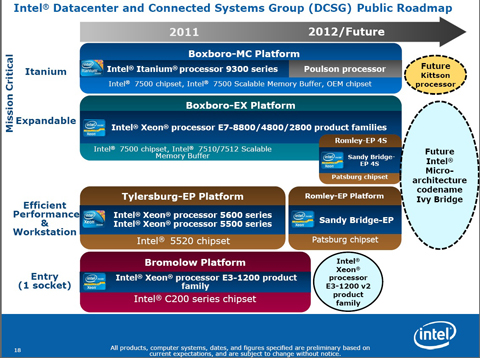HP Superdome - dead as a dodo?


John Appleby says:
I had a slightly uncomfortable conversation with one of my sales people this week, who told me that one of their customers had just bought a brand new HP Superdome2 and wanted to know if our software would run SAP software. I had to explain to him that the SAP BusinessObjects portfolio no longer runs on that platform.
And in case you think they are being lazy, Oracle will not be developing for this platform any more. In case you think Larry Ellison is trying to screw HP, neither are Microsoft – neither for their Windows OS (the last version is Windows 2008 R2) or for their SQL Server RDBMS. Nor is Linux vendor Redhat.
In case you think there is a software vendor conspiracy, there are now only 5 vendors that sell Intel Itanium based systems: HP, Bull, NEC, Inspur and Huawei. And I hear that over 90% of the CPUs are bought for HP systems. So what’s wrong with it? Let’s see…
HP is paying Intel to keep it alive
When Oracle ceased development on the platform, HP went nuts and sued them for saying that Itanium was dead. It rather backfired when it turned out that HP was paying Intel $690m to keep it alive. Given HP’s precarious state right now, it would be remiss to suggest that this were a winning strategy.
Pace of innovation
The current chip was codenamed Tukwila and 2 years late to market. With 2 year old features and performance. It has under half the performance per core of equivalent Intel x64 and IBM Power7 CPUs as well as 50% more power consumption. The top-end CPU is 185W and 4 cores compared to the Intel Westmere-EX which is 130W and 10 cores. Yes – 1/4 the power per core and 5x the performance per socket.
The next generation CPU, Poulson, was scheduled for 2009 and still hasn’t been delivered in 2012. I think you know where Intel is investing its R&D: the successor to the x64 Westmere-EX platform, called Ivy Bridge.
Resilience, Availability & Serviceability
This used to be the reason to buy Itanium. But unfortunately in many ways, the Intel Westmere-EX has better RAS features than Itanium. Westmere-EX can predict and exclude memory failure, recover from memory failures and mirror memory. Plus Westmere-EX can predict and re-route chip interconnect (QPI) failures and recover. It is literally bulletproof.
Itanium has 2-year old technology in this respect and the pace of innovation in this area is really important because of in-memory computing.
Size and Power
This part is scary. A typical HP Superdome 128-core system is 6’6? high. An equivalent IBM Westmere-EX 80-core system is 12? high. The HP unit will use 6kW for the CPUs alone and the IBM will use 1kW. Obviously add some more for memory and other stuff, but you get the idea. Itanium is 1/6 the power performance. And will take up large swathes of datacenter space. And kill a lot of trees.
Angry Larry
Oracle have gone heavily after HP here with their “Cash for Clunkers” programme. Now this is typical Oracle bully behaviour but it is hard to argue with their logic.
HP Superdome customers are facing costly “forklift upgrades” when upgrading from dead-end PA-RISC and Itanium processors and HP-UX.
Now you can trade in your legacy HP Superdome servers and receive a 50% discount on Oracle’s Sun SPARC Enterprise M8000 and M9000 servers—secure and highly available servers for running mission-critical, enterprise database and business applications.
And this has had a dramatic effect on revenue – HP Itanium sales are falling quarter on quarter and are below $400m per quarter – falling from over $800m in Q4 2010. HP is suing Oracle over this but the damage has been done.
Note that a blogger went after Oracle for this with “who’s the clunker?“, but it is an awful article. Notably, the SPARC platform has a 5-year roadmap. The closest thing I can find to this from HP is Project Odyssey, which looks suspiciously like a roadmap to migrate customers from HP-UX/Itanium to Linux/x86, or this one that is from 2009.
Features & Function Comparison
Someone wrote a comparison of HP and Oracle on this which was clearly biased so I thought I would lay down some facts! Lets compare 3 roughly similarly powered systems (by SAP’s application benchmark). Please note that HP have not certified any systems so I had to estimate their SAPS rating based on data available for the SPEC benchmark.
| HP Superdome2 | IBM POWER7 | Intel Westmere-EX | |
| CPU | 32-CPU (128-core) | 8-CPU (64-core) | 8-CPU (80-core) |
| SAP SD 2-tier benchmark | 120k SAPS (940 SAPS/core) | 200k SAPS (3125 SAPS/core) | 120k SAPS (1500 SAPS/core) |
| Configuration & Cost | 512 GB of memory with HP-UX and 3 years basic HW and SW support lists for $1,722,390 | 512GB of memory, AIX UNIX and 3 years basic HW and SW support lists for <$1,000,000 | Intel Westmere-EX with 512GB of memory, SuSe Linux and 3 years basic HW and SW support lists for <$100,000 |
| Size and Power Consumption | 36U / 9kW | 8U / 3.2KW | 8U / 4kW |
| Roadmap | 2 more generations of Itanium, the first of which is 3 years late to market. | There is a commitment to 2 more generations of IBM POWER and they have a detailed roadmap available here. | See the below image to see the focus on x64 roadmap! |
| Scalability (single-system) | 128-cores, 4TB RAM, 240k SAPS | 256-cores, 8TB RAM, 700k SAPS | 80-cores, 3TB RAM, 120k SAP |

What will be the death knoll?
This is interesting because 95% of Itanium systems were shipped by HP in 2008, according to Gartner. 90% of those that run Itanium for SAP run the HP-UX OS. I’d love to see the stats but from my SAP statistics vs the overall systems sold, I estimate that at least 30% of those are used to run SAP – I suspect this is the biggest single software vendor that runs Itanium.
And SAP hasn’t said so, but they will stop development on the Itanium platform. They have to because the only database that runs on that platform is Oracle 11g (or MSSQL on Windows 2008).
Disclosure: This is a republished post from John Appleby's original post.
Add to this SAP’s promotion program around its own Sybase ASE database and HP’s financial inability to prop up Itanium and perhaps you will agree that the Superdome will move from an endangered species to a dead duck.